-
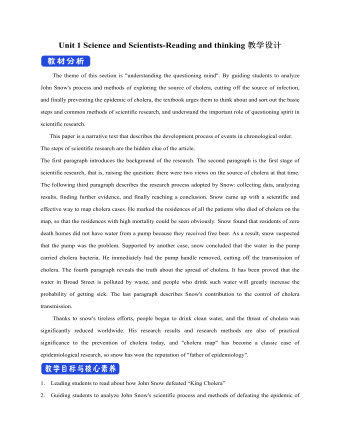
新人教版高中英语选修2Unit 1 Science and Scientists-Reading and thinking教学设计
Step 5: After learning the text, discuss with your peers about the following questions:1.John Snow believed Idea 2 was right. How did he finally prove it?2. Do you think John Snow would have solved this problem without the map?3. Cholera is a 19th century disease. What disease do you think is similar to cholera today?SARS and Covid-19 because they are both deadly and fatally infectious, have an unknown cause and need serious public health care to solve them urgently.keys:1. John Snow finally proved his idea because he found an outbreak that was clearly related to cholera, collected information and was able to tie cases outside the area to the polluted water.2. No. The map helped John Snow organize his ideas. He was able to identify those households that had had many deaths and check their water-drinking habits. He identified those houses that had had no deaths and surveyed their drinking habits. The evidence clearly pointed to the polluted water being the cause.3. SARS and Covid-19 because they are both deadly and fatally infectious, have an unknown cause and need serious public health care to solve them urgently.Step 6: Consolidate what you have learned by filling in the blanks:John Snow was a well-known _1___ in London in the _2__ century. He wanted to find the _3_____ of cholera in order to help people ___4_____ it. In 1854 when a cholera __5__ London, he began to gather information. He ___6__ on a map ___7___ all the dead people had lived and he found that many people who had ___8____ (drink) the dirty water from the __9____ died. So he decided that the polluted water ___10____ cholera. He suggested that the ___11__ of all water supplies should be _12______ and new methods of dealing with ____13___ water be found. Finally, “King Cholera” was __14_____.Keys: 1. doctor 2. 19th 3.cause 4.infected with 5.hit 6.marked 7.where 8.drunk 9.pump 10.carried 11.source 12.examined 13.polluted 14.defeatedHomework: Retell the text after class and preview its language points
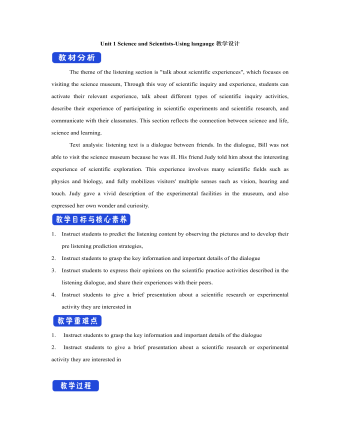
新人教版高中英语选修2Unit 1 Science and Scientists-Using langauge教学设计
This happens because the dish soap molecules have a strong negative charge, and the milk molecules have a strong positive charge. Like magnets, these molecules are attracted to each other, and so they appear to move around on the plate, taking the food coloring with them, making it look like the colors are quickly moving to escape from the soap.Listening text:? Judy: Oh, I'm so sorry that you were ill and couldn't come with us on our field trip. How are you feeling now? Better?? Bill: Much better, thanks. But how was it?? Judy: Wonderful! I especially liked an area of the museum called Light Games.it was really cool. They had a hall of mirrors where I could see myself reflected thousands of times!? Bill: A hall of mirrors can be a lot of fun. What else did they have?? Judy: Well, they had an experiment where we looked at a blue screen for a while, and then suddenly we could see tiny bright lights moving around on it. You'll never guess what those bright lights were!? Bill: Come on, tell me!? Judy: They were our own blood cells. For some reason, our eyes play tricks on us when we look at a blue screen, and we can see our own blood cells moving around like little lights! But there was another thing I liked better. I stood in front of a white light, and it cast different shadows of me in every color of the rainbow!? Bill: Oh, I wish I had been there. Tell me more!? Judy: Well, they had another area for sound. They had a giant piano keyboard that you could use your feet to play. But then, instead of playing the sounds of a piano, it played the voices of classical singers! Then they had a giant dish, and when you spoke into it, it reflected the sound back and made it louder. You could use it to speak in a whisper to someone 17 meters away.? Bill: It all sounds so cool. I wish I could have gone with you? Judy: I know, but we can go together this weekend. I'd love to go there again!? Bill: That sounds like a great idea!
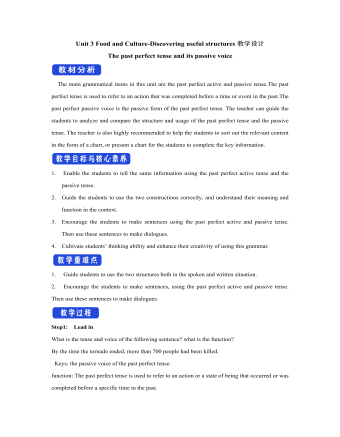
新人教版高中英语选修2Unit 3 Food and Culture-Discovering useful structures教学设计
The newspaper reported more than 100 people had been killed in the thunderstorm.报纸报道说有一百多人在暴风雨中丧生。(2)before、when、by the time、until、after、once等引导的时间状语从句的谓语是一般过去时,以及by、before后面接过去的时间时,主句动作发生在从句的动作或过去的时间之前且表示被动时,要用过去完成时的被动语态。By the time my brother was 10, he had been sent to Italy.我弟弟10岁前就已经被送到意大利了。Tons of rice had been produced by the end of last month. 到上月底已生产了好几吨大米。(3) It was the first/second/last ... time that ...句中that引导的定语从句中,主语与谓语构成被动关系时,要用过去完成时的被动语态。It was the first time that I had seen the night fact to face in one and a half years. 这是我一年半以来第一次亲眼目睹夜晚的景色。(4)在虚拟语气中,条件句表示与过去事实相反,且主语与谓语构成被动关系时,要用过去完成时的被动语态。If I had been instructed by him earlier, I would have finished the task.如果我早一点得到他的指示,我早就完成这项任务了。If I had hurried, I wouldn't have missed the train.如果我快点的话,我就不会误了火车。If you had been at the party, you would have met him. 如果你去了晚会,你就会见到他的。
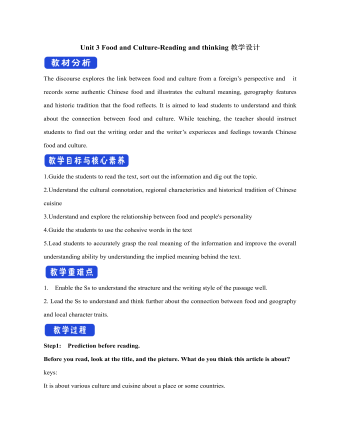
新人教版高中英语选修2Unit 3 Food and Culture-Reading and thinking教学设计
The discourse explores the link between food and culture from a foreign’s perspective and it records some authentic Chinese food and illustrates the cultural meaning, gerography features and historic tradition that the food reflects. It is aimed to lead students to understand and think about the connection between food and culture. While teaching, the teacher should instruct students to find out the writing order and the writer’s experieces and feelings towards Chinese food and culture.1.Guide the students to read the text, sort out the information and dig out the topic.2.Understand the cultural connotation, regional characteristics and historical tradition of Chinese cuisine3.Understand and explore the relationship between food and people's personality4.Guide the students to use the cohesive words in the text5.Lead students to accurately grasp the real meaning of the information and improve the overall understanding ability by understanding the implied meaning behind the text.1. Enable the Ss to understand the structure and the writing style of the passage well.2. Lead the Ss to understand and think further about the connection between food and geography and local character traits.Step1: Prediction before reading. Before you read, look at the title, and the picture. What do you think this article is about?keys:It is about various culture and cuisine about a place or some countries.
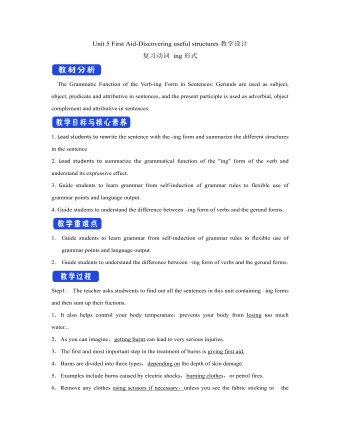
新人教版高中英语选修2Unit 5 First Aid-Discovering useful structures教学设计
You have no excuse for not going.你没有理由不去。He was punished for not having finished his homework.他因未完成作业而受到惩罚。2.动词ing形式复合结构由物主代词或人称代词宾格、名词所有格或普通格加动词ing,即“sb./sb.'s+doing”构成。动词ing形式的复合结构实际上是给动词ing形式加了一个逻辑主语。动词ing形式的复合结构有四种形式:①形容词性物主代词+动词ing②名词所有格+动词ing③代词宾格+动词ing④名词+动词ingHer coming to help encouraged all of us.她来帮忙鼓舞了我们所有人。The baby was made awake by the door suddenly shutting.这个婴儿被突然的关门声吵醒了。Can you imagine him/Jack cooking at home?你能想象他/杰克在家做饭的样子吗?无生命名词无论是作主语还是作宾语都不能用第②种形式。Tom's winning first prize last year impressed me a lot.汤姆去年得了一等奖使我印象深刻。Do you mind my/me/Jack's/Jack leaving now?你介意我/杰克现在离开吗?Excuse me for my not coming on time.很抱歉我没能按时来。His father's being ill made him worried.他父亲病了,他很担心。We are looking forward to the singer's/the singer to give us a concert.我们盼望着这位歌手来给我们举办一场演唱会。
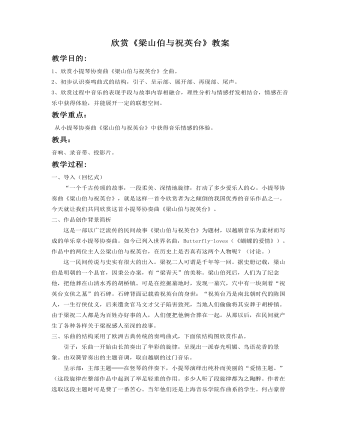
欣赏《梁山伯与祝英台》教案
一、导入(回忆式) “一个千古传颂的故事,一段柔美、深情地旋律,打动了多少爱乐人的心。小提琴协奏曲《梁山伯与祝英台》,就是这样一首令欣赏者为之倾倒的我国优秀的音乐作品之一。今天就让我们共同欣赏这首小提琴协奏曲《梁山伯与祝英台》。二、作品创作背景简析这是一部以广泛流传的民间故事《梁山伯与祝英台》为题材,以越剧音乐为素材而写成的单乐章小提琴协奏曲。如今已列入世界名曲,Butterfly-loves(《蝴蝶的爱情》)。作品中的两位主人公梁山伯与祝英台,在历史上是否真有这两个人物呢?(讨论。)这一民间传说与史实有很大的出入。梁祝二人可谓是千年等一回。据史册记载,梁山伯是明朝的一个县官,因秉公办案,有“梁青天”的美称。梁山伯死后,人们为了纪念他,把他葬在山清水秀的胡桥镇。可是在挖掘墓地时,发现一墓穴,穴中有一块刻着“祝英台女侠之墓”的石碑。石碑背面记载着祝英台的身世:“祝英台乃是南北朝时代的陈国人,一生行侠仗义,后来遭贪官马文才父子陷害致死,当地人们偷偷将其安葬于胡桥镇。由于梁祝二人都是为百姓办好事的人,人们便把他俩合葬在一起。从那以后,在民间就产生了各种各样关于梁祝感人至深的故事。三、乐曲的结构采用了欧洲古典传统的奏鸣曲式,下面依结构图欣赏作品。引子:乐曲一开始由长笛奏出了华彩的旋律,呈现出一派春光明媚、鸟语花香的景象。由双簧管奏出的主题音调,取自越剧的过门音乐。呈示部:主部主题──在竖琴的伴奏下,小提琴演绎出纯朴而美丽的“爱情主题。”(这段旋律在整部作品中起到了举足轻重的作用。多少人听了段旋律都为之陶醉。作者在选取这段主题时可是费了一番苦心。当年他们还是上海音乐学院作曲系的学生。何占豪曾在杭州越剧团当演员,他对越剧音乐既熟悉又喜爱。在创作《梁祝》时,故事流传在浙江一带,越剧是浙江的代表剧种,他决心从越剧音乐中取材。据平时的观察,许多越剧名演员,不论他们演出任何剧目,只要唱到一段唱腔时,台下都会博得热烈地掌声为之呼应。作者抓住了这段唱腔作为《梁祝》中“爱情主题”的基本音调。这段主题是全曲的核心的音调。)
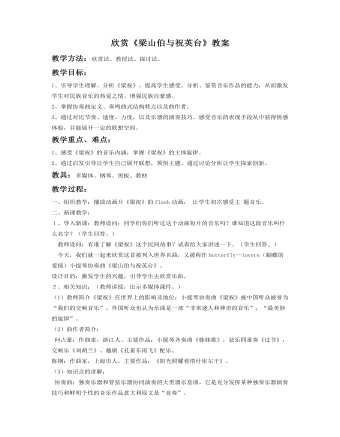
欣赏《梁山伯与祝英台》教案
教学过程:一、组织教学:播放动画片《梁祝》的flash动画, 让学生初次感受主 题音乐。二、新课教学:1、导入新课:教师设问:同学们你们听过这个动画短片的音乐吗?谁知道这段音乐叫什么名字?(学生回答。) 教师设问:有谁了解《梁祝》这个民间故事?试着给大家讲述一下。(学生回答。) 今天,我们就一起来欣赏这首被列入世界名曲,又被称作butterfly—lovers(蝴蝶的爱情)小提琴协奏曲《梁山伯与祝英台》。设计目的:激发学生的兴趣,引导学生去欣赏乐曲。2、相关知识:(教师讲授,出示多媒体课件。)(1)教师简介《梁祝》在世界上的影响及地位:小提琴协奏曲《梁祝》被中国听众被誉为“我们的交响音乐”。外国听众也认为乐曲是一部“非常迷人和神奇的音乐”,“最美妙的旋律”。(2)曲作者简介: 何占豪:作曲家,浙江人。主要作品:小提琴齐奏曲《姊妹歌》,弦乐四重奏《过节》,交响乐《刘胡兰》、越剧《孔雀东南飞》配乐。陈钢:作曲家,上海市人。主要作品:《阳光照耀着塔什库尔干》。(3)知识点的讲解: 协奏曲:独奏乐器和管弦乐器协同演奏的大型器乐套曲,它是充分发挥某种独奏乐器演奏技巧和鲜明个性的音乐作品意大利原文是“竞奏”。3、下面,欣赏《梁祝》的主要部分音乐。
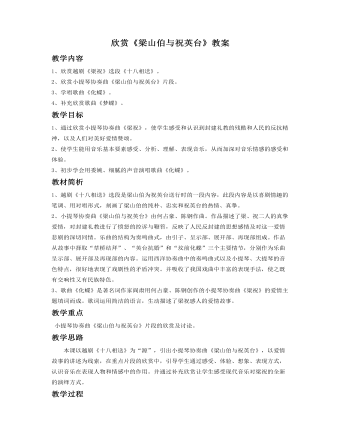
欣赏《梁山伯与祝英台》教案
教学过程第一环节:恋蝶——欣赏越剧《十八相送》感受越剧韵味,了解越剧。 1、提问导入特点,并为欣赏下一作品做好铺垫。(1)越剧是浙江地方戏剧剧种之一,你能说出一些著名的越剧代表作品吗?(2)导出越剧《梁祝》并请学生说说梁祝故事。(3)教师小结。(4)欣赏越剧《十八相送》。(5)简单介绍越剧特点(唱腔、语言)。第二环节:颂碟——欣赏小提琴协奏曲《梁祝》片断。1、导入:介绍作品地相关知识。(1)教师:这个千古传颂的爱情故事可以用越剧的形式来表现。那么,我们是否可以用其他形式来表现呢?我们中国就有两位作曲家何占豪和陈刚,他们为了探索交响音乐的民族化,选择了这一家喻户晓的民间传说为题材,吸取越剧中的曲调为素材,运用西洋手法,成功地创作了一部小提琴协奏曲《梁祝》。(2)介绍乐器小提琴、大提琴(出示图片)。 2、欣赏“爱情主题”(1)请学生聆听爱情主题音乐根据提问,让学生思考:①这段主旋律由哪样乐器演奏? ②这段主旋律有什么特点?自主参与讨论分析作品。(2)学生思考并回答。(3)教师总结: 旋律优美动听、委婉曲折,带有越剧韵味。节奏舒缓,情绪明朗。表现出爱情的美好。3、介绍协奏曲 协奏曲是指一种由独奏乐器与管弦乐队协同演奏的大型器乐作品。在音乐 进行中,独奏乐器与乐队常常轮流出现,独奏时乐队处于伴奏地位。全奏时,独奏乐器休止,完全由乐队演奏。
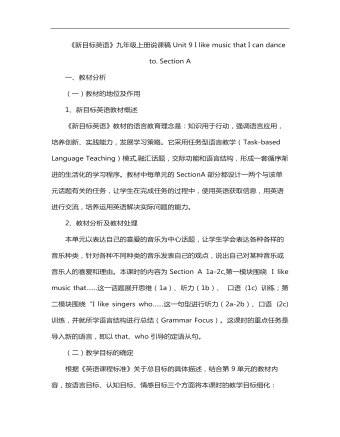
初中英语人教版九年级全册《Unit 9 I like music that I can dance to》说课稿
2、教材分析及教材处理本单元以表达自己的喜爱的音乐为中心话题,让学生学会表达各种各样的音乐种类,针对各种不同种类的音乐发表自己的观点,说出自己对某种音乐或音乐人的喜爱和理由。本课时的内容为Section A 1a-2c,第一模块围绕 I like music that……这一话题展开思维(1a)、听力(1b)、 口语 (1c) 训练;第二模块围绕“I like singers who……这一句型进行听力(2a-2b)、口语 (2c) 训练,并就所学语言结构进行总结(Grammar Focus)。这课时的重点任务是导入新的语言,即以that、who引导的定语从句。
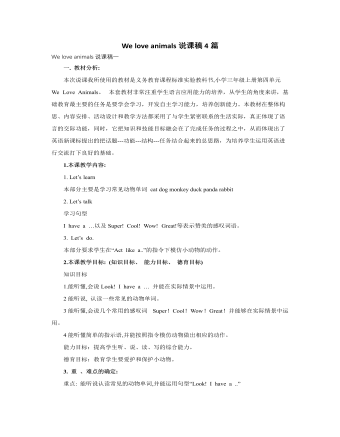
人教版新课标PEP小学英语三年级上册We love animals说课稿4篇
能力目标:培养学生听,做,说,读,写的能力,增进身体各部分的协调能力,语言表达能力。情感目标:让学生通过运用语言来完成学习任务,感受成功,从而引发和培养学生学习英语的内在动机,最终使他们形成英语学习的积极态度。同时培养学生要爱护动物。2. 教学重难点本课的教学重点是让学生能听、说、认读六个有关动物的词汇。教学难点是学生能将这六个有关动物的词汇运用到简单的英语句子中表达,突破重点和难点的关键是结合低年级学生喜欢游戏的特点,通过玩游戏,使单调的知识溶进生动的活动之中,让学生在听,做,动的过程中,掌握知识,并灵活地运用。三.说教法1.教法设计为了顺利完成以上教学目标,更好地突出重点,突破难点,按照学生的认识规律,我采用了讲读、直观演示、愉快教学相结合的方法,层层递进,激发学生的学习兴趣,充分调动他们学习的积极性,保持他们强烈的好奇心和旺盛的求知欲,进而促使他们由兴趣发展到产生要学好它的志趣。

人教版新课标PEP小学英语三年级下册My family说课稿6篇
(1)单词:father (dad), mother (mom), grandfather (grandpa), grandmother (grandma), man, woman(2)学唱英语童谣《Father and Mother》。难点:表示家庭成员单词的认读三、说学情三年级第二学期的学生,能够认读少量简单的单词;但是由于英语不是我们的母语,在日常生活中少于应用,学生学得快,忘得也快,在口语交流能力方面很差。因此,在教学中要结合学生的实际情况,采取有效的教学方法进行教学。四、说教法根据教学内容的特点,我在教学中①注重主题化整体设计,以family为主线贯穿始终,结合远程教育资源的利用,给学生创设一个轻松、愉快的学习氛围。②注重在课堂教学中充分体现“以学生为主体”的教学原则,营造“真实性”的语言环境和开放的空间,让学生在交际中学习运用。③在教学过程中设计各种教学活动,让他们在唱中学,在做中学,在玩中学,从而充分调动其学习兴趣,同时还注重培养学生各项能力训练。五、说学法

人教版新课标PEP小学英语三年级下册Welcome back to school说课稿4篇
2、学生小组间的问答:“Where are you from?”“I’m from…”(根据孩子自己制作的头饰回答)3、请几个小组开火车问答:“Where are you from?”4、教师出示钟表(把时间调到下午):“Good afternoon!”教师带上Mr. Black的头饰(走到一位学生面前)说:“Good afternoon! My name’s Mr. Black. I ’m from China.”孩子根据自己的情况回答:“Good afternoon, Mr. Black. I’m Xiao Dong . I’m from China.”教师提问一组孩子。然后请学生到前面来扮演Mr. Black.5、教师带着Mr. Black 的头饰走到台前,说:“I have a friend in our class. Do you know who’s she?”教师指着扮演Amy的同学说: “This is my friend Amy.”(引导全班孩子问好)Ss: Nice to meet you.A: Nice to meet you, too!Ss: Where are you from?A: I’m from America.Ss: Welcome!6、教师播放Let’s talk部分的课件, 学生观看对话。跟读、模仿,分角色给课件配音。7、小组分角色练习对话。8、小组表演对话。趣味操练 (Practice)1、Listen and order the cards: 将课文图片打乱顺序,让孩子听一听, 摆一摆。2、表演Let’s talk部分的对话。

人教版新课标PEP小学英语三年级下册Where is my ruler说课稿7篇
1、教学内容PEP Primary English BookⅡ Where’s my ruler?第一课时 A. Let’s talk. Let’s practise. C. Culture.2、教材简析本单元的核心教学内容是找东西和借东西的话题与交通工具,学生生活用品的词汇教学及六个字母(Uu Vv Ww Xx Yy Zz)的听、说、读、写。①Let’s talk. 会话学习。本课时通过寻找东西这一情境,学习句型Where is …?及掌握介词in 、on 和under的用法,让学生在模仿、学习表演的基础上达到自然交流和真实运用。②Let’s practise. 会话游戏活动,让学生在游戏中熟练运用所学问句。③Culture. 文化交流,渗透C部分中“六一”国际儿童节的文化内容,并学唱《Happy Children’s Day》。根据小学英语会话循序渐进的特点,此课作为第一课时,为整个单元教学打好基础,作好教学铺垫。同时,在整一个小学英语教学中,作为交际功能的一部分,它也是一个不可或缺的部分。
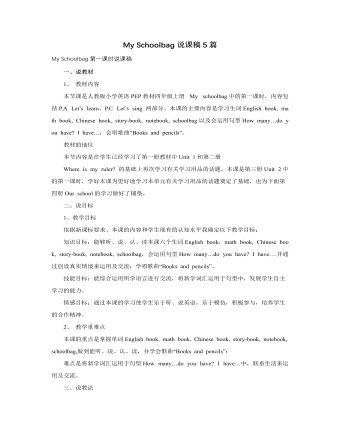
人教版新课标PEP小学英语四年级上册My Schoolbag说课稿5篇
(1)Sing a song.由于老师是借班上课,师生间难免会由于陌生而产生距离,所以选一首大家都熟悉的歌曲可以把师生间的距离拉近。(2)通过听指令做动作(如:point to the window , point to the door ….)等复习第一单元的知识,同时为进入本单元的schoolbag作铺垫。第二步:. Presentation 激情引趣,学习新知(1)由point to the bag 导入课题(板课题) 并引导学生说。(2)多媒体课件呈现所学新单词。学习单词按易到难,由浅入深原则逐一学习。先从大家熟悉的English book入手,然后到Chinese book, math book, notebook ,。由于story-book比较难发音,因此安排在最后。(3)通过图片、单词卡片、课本让学生反复指认这些单词。(4)Guessing game .让学生快速抢猜单词。(5)教学句型:How many …do you have? I have….通过学生与老师 ,老师与老师之间的对话来加强学习,在同学们熟悉单词后,引导他们加入How many …do you have? I have….进行操练。
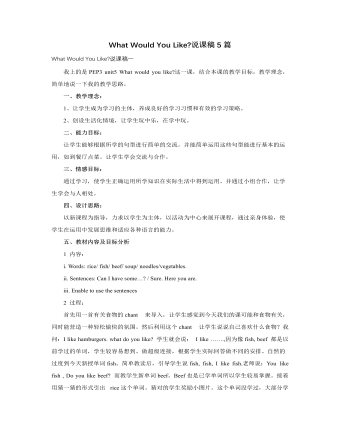
人教版新课标PEP小学英语四年级上册What Would You Like说课稿5篇
为了达到教学目标,解决本课时中的重点和难点,我进行了以下步骤的教学。首先是课前热身,我与学生进行了一些日常会话的练习,让学生进入英语学习的状态。在日常会话中,我还问到了Do you like apples/hamburgers/hot dogs/…?Yes,I do./No,I don’t.涉及到了学生在三年级时学过的一些食物、水果等。接着,我让学生猜了一些有关食物的单词,采用用手指书空和看口型猜的方法,集中学生的注意里,激发他们的学习兴趣。复习了食物单词之后,我用了三年级时学的一个Let’s do,让学生在快乐的学习氛围中投入到本节课的习。在新课呈现部分,我用Today I have more food for you.进入新课的学习。用课件出示六个盘子,请学生上来用鼠标选择,随机学习新单词,提醒学生注意单词的发音,有的单词学习的时候用已经学过的单词引出,有些则用一些用chant进行巩固教学。
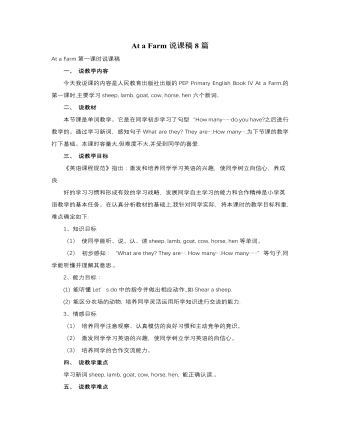
人教版新课标PEP小学英语四年级下册At a Farm说课稿8篇
一、说教材《At a Farm》是义务教育课程标准实验教科书英语(PEP)四年级下册的内容。本课要求在理解课文的基础上掌握五个动物的单词“cat, rabbit, pig, duck, dog”和两个句子“Are they ducks? No, they aren’t.”本节课是四年级下册第六单元第三课时。本单元重点学习农场上常见的牲畜和蔬菜名称以及包含名词复数的一般疑问句,而学生在学习了前两课时之后,排除了句型上的困难,而且这五个单词在以前的学习中也见到过,所以要把单词和句型的规范书写放在首位,打牢基础,还要培养学生在理解课文基础上朗读课文的能力。我确定了三个教学目标。1、能够听、说、读、写“cat, rabbit, duck, pig, dog”这五个动物单词以及句子“Are they ducks? No, they aren’t.”2、能够理解并试唱Let’s chant部分的歌谣。3、能够总结五个元音字母的发间规律。重点:掌握五个动物名词以及句型的拼写。难点:准确朗读课文和五个元音字母的发音规律。

人教版新课标PEP小学英语四年级下册What Time Is It说课稿5篇
三.说教学设计1.Warm-up用Free talk 的方式复习上一课的几个句型。For example: What’s this? // Is this a pen ?/Yes, it is./No, it isn’t.Where is your classroom?How many Ss are there in your class?……用几个How many句型引出数字,达到复习和引出新课的目的,然后sing a song 用数字歌营造良好的英语学习气氛,也为新课呈现做好铺垫。2.Presentation//PracticeA.通过把数字1----12用圆圈起来的方式做出一面钟,从而学习句型What time is it? It’s…… o’clock. 用钟更换不同的时间,让学生操练此句型。B.学生通过图片了解了ZhangPeng 的一天,从而通过单词卡学习新单词:music class, P.E. class, English class, breakfast, lunch, dinner.在单词教学中,我先让学生跟读,拼读,认读,再采用游戏,比赛的方式进一步操练巩固单词,为下一步操练句型打基础。C.在熟练的操练单词之后,结合第一步的句型,引出新句型It’s time for……让学生结合单词句型进行操练。在操练过程中吧Let’s do的内容自然地溶入。在操练Let’s do的时候可边读边做动作让学生通过了解动作了解句子的意义。
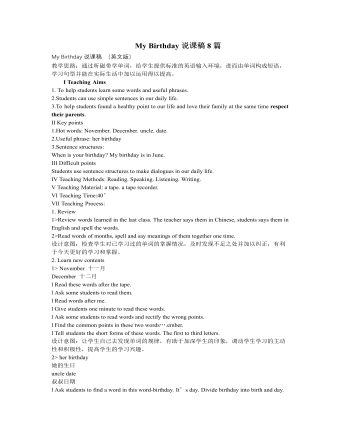
人教版新课标PEP小学英语五年级下册My Birthday说课稿8篇
二、新授环节新授环节是本堂课的重点,我主要分为6步来突破语言点,步步为营,环环相扣,达到既定目标。1、首先我用touch and guess游戏来呈现新授单词present,通过CAI展示各种生日礼物,如衣服,书本,玩具等让学生操练单词:Books can be a present等,操练时做到词不离句。2、接着我借助多媒体让学生说说自己想要的礼物I want a_____,同时我将实现准备的实物和图片作为礼物赠送给他们,新授句子Here’s a present for you,激发学生开口说的兴趣,又为接下来的操练提供了资源。我利用刚才分发的礼物采用游戏 “I’m a little bee”, (S1:I’m a little bee. Today is my birthday. S3:Here’a present for you。)四人小组合作操练这个句型。既避免了操练的机械性又调动了学生的积极性,而且提供了让每个学生开口说的机会,关注学生个体的发展。3、当学生Act完后,我对一学生说:Oh, little bee, what’s your present? Open it and see。让学生打开礼物呈现实物生日贺卡教学词汇birthday card。既做到了呈现自然,又渗透西方文化知识,培养学生跨文化交际意识。
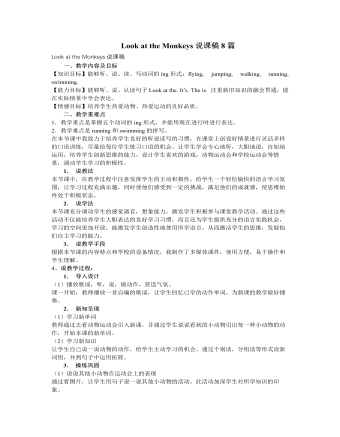
人教版新课标PEP小学英语五年级下册Look at the Monkeys说课稿8篇
四、拓展提高,评价促学1、欣赏故事。在学习完所有内容后,老师请学生继续听、看和试着说出这个童话故事的一部分,然后通过拜访几个动物的家庭,利用我们眼睛看到的事物,我举例示范了一个对话,并根据听到的内容将所缺少的单词填写进去。在原来听、说、读的基础上,增加了写的环节,真正完成了单词的四会要求。2、童话表演。这个童话故事将所有的内容综合在一起,是单词与句型的综合运用。在学生听说读写的训练过程之后,两人小组的表演培养了学生的合作学习能力,让学生们通过师生、生生、小组等不同的合作方式,学会倾听,学会评价。3、中心升华。最后,我利用小鸟的眼睛,我们一起欣赏了大千世界各种美丽的事物,让学生学习之余,能够有所减压和感受,连青蛙都喜欢上整个世界,跳出了小井,感受整个世界的美好。五、课堂小结,作业布置(1) 抄写所学的四会单词。(2)将童话剧表演给父母看。这一环节培养了学生语言的运用能力,体验学习英语的成功带来的喜悦,达到学以致用的目的。
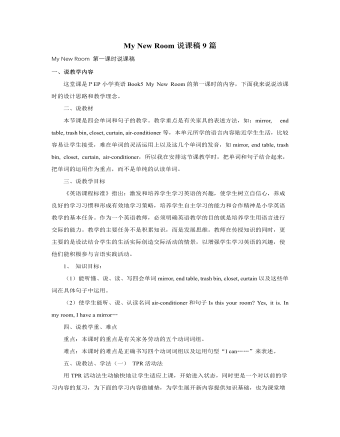
人教版新课标PEP小学英语五年级上册My New Room说课稿9篇
二、说教法和学法三、说教学过程(一)warming up小学生贪玩,刚上课,即使身体“规矩”了,心一时还是静不下来。为了让学生尽快进人学习状态,教学前的热身活动是非常必要的。本课我设计的热身活动既能起到热身作用,又能起到复习作用。复习旧知,能让学生感到新知识并不陌生,学起来会更有信心,同时也自然降低了新知的难度。首先我用简单的英语和学生之间进行简单的对话,接着是唱上个单元的歌曲和歌谣。通过这两个热身活动,学生充满激情地进入到语言学习状态中,同时以旧带新,为后面新知识的学习做了铺垫。(二)Prensentation1.Let’s talk.这一部分是以谈话的形式出现新的句型和知识点。要求学生们通过学习。运用新知进行交谈。首先我出示一个房间的课件,然后在房间里出教师本人,然后介绍说:“Look,this is me. I have my own room now.”, 强调“my own room”的发音,让学生跟说。

